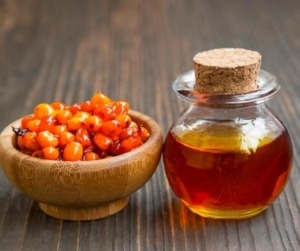Sea buckthorn oil contains relatively higher carotenoids than other fruits. Studies have shown significant differences in terms of the composition and content of carotenoids due to the genetic variation, geographic location, growing conditions, stage of maturity when harvested, storage conditions, and methods of analysis.
Carotenoid composition of sea buckthorn oil.
| No. | Compound | Carotenoid Concentration | |
| mg/100 g a | % | ||
| 1 | Lutein | 8.95 ± 0.22 | 2.95 |
| 2 | Zeaxanthin | 9.74 ± 0.90 | 3.21 |
| 3 | 15-cis-β-carotene | 6.13 ± 0.20 | 2.03 |
| 4 | all-trans-β-carotene | 10.61 ± 0.41 | 3.50 |
| 5 | α-carotene | 5.76 ± 0.49 | 1.90 |
| 6 | Zeaxanthin myristate | 8.71 ± 0.61 | 2.88 |
| 7 | Zeaxanthin palmitate | 10.69 ± 0.71 | 3.53 |
| 8 | β-cryptoxanthin myristate | 10.00 ± 0.89 | 3.30 |
| 9 | Lutein oleate | 11.88 ± 0.80 | 3.92 |
| 10 | β-cryptoxanthin palmitate | 18.27 ± 0.42 | 6.03 |
| 11 | Zeaxanthin dimyristate | 21.26 ± 0.15 | 7.02 |
| 12 | Zeaxanthin palmitate-palmitoleate | 19.76 ± 0.22 | 6.52 |
| 13 | Zeaxanthin myristate-palmitate | 46.08 ± 0.92 | 15.22 |
| 14 | Zeaxanthin dipalmitate | 114.98 ± 1.03 | 37.97 |
an average of triplicate samples.
 Cold-pressed sea buckthorn oil had a high content of total carotenoids. Fourteen carotenoids were identified and lutein, zeaxanthin, β-carotene, and α-carotene represented the free carotenoid fraction. Free and esterified forms of zeaxanthin amounted to 76.35% of the identified carotenoids. As shown in the above table, the most abundant compound was zeaxanthin, mainly in its esterified form with two molecules of palmitic acid and zeaxanthin dipalmitate. During ripening, xanthophylls such as zeaxanthin develop into esterified forms which constitute more stable forms of carotenoid storage in sea buckthorn fruits.
Cold-pressed sea buckthorn oil had a high content of total carotenoids. Fourteen carotenoids were identified and lutein, zeaxanthin, β-carotene, and α-carotene represented the free carotenoid fraction. Free and esterified forms of zeaxanthin amounted to 76.35% of the identified carotenoids. As shown in the above table, the most abundant compound was zeaxanthin, mainly in its esterified form with two molecules of palmitic acid and zeaxanthin dipalmitate. During ripening, xanthophylls such as zeaxanthin develop into esterified forms which constitute more stable forms of carotenoid storage in sea buckthorn fruits.
The total carotenoid content of sea buckthorn berries from Romanian varieties ranged between 53 and 97 mg/100 g dry weight, with zeaxanthin dipalmitate present in the highest amount. Three sea buckthorn species from the cold deserts of the Himalayas were investigated and the total carotenoid content ranged from 692 to 3420 mg/kg. Depending on the origin of the berries, the total carotenoid content in sea buckthorn oil can reach 314–2139 mg carotenoids/100 g in varieties from China, and 900–1000 mg/100 g in sea buckthorn oil from the Pamir region.

Leave A Comment